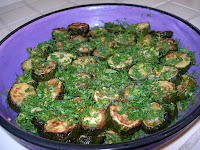I need to visit New Mexico once a year. Primarily I need to see my dear friends Anne Sigler and George Muedeking who left the Bay area a couple of years ago and now live in the East Mountains outside of Albuquerque. But there are a couple of other reasons as well. I have to see the sky. Living as I do in urban areas, I don’t see enough of the sky from one horizon to another and I need it; my spirit needs it. And then there is the food. I love New Mexican Green Chile stews. On a recent trip I had an excellent one at the café at Acoma Pueblo some ways south of Albuquerque. The café’s stew replaced the tomatoes in the recipe below with chicken stock and added a little more heat, but in all other ways was like this one. Just lovely. The café served it with plain white bread. I think flour tortillas and especially
Lemon Cornbread are great along side the stew. A friend of mine fancies the cornbread crumbled into the stew.
2 pounds boneless pork butt or shoulder, cut into 1-inch cubes
3 tablespoons all-purpose flour
2 tablespoon olive oil, butter, lard, or bacon fat
1 cup chopped onions
2 garlic cloves, minced
6 fresh tomatoes, cored and chopped
OR
1 28-ounce can diced tomatoes
2 teaspoons salt plus more to taste
1½ teaspoons dried Mexican oregano
1 teaspoon ground cumin
½ teaspoon ground coriander
¼ teaspoon ground chipotle chile powder or to taste—this provides the heat
¼ cup chicken stock, if necessary
10 poblano (sometimes called pasilla) chiles or Anaheim chiles, roasted, peeled, seeded, and chopped, see roasting
instructions if you need them
Note: These are fresh, green and mild. You can do this process ahead. In a pinch you could use canned chiles.
1 yellow summer squash or yellow zucchini, quartered lengthwise and cut into ½-inch slices
1 green zucchini, quartered lengthwise and cut into ½-inch slices
1 ear fresh corn, kernels removed
1 bunch cilantro, leaves removed and chopped
Sour cream
1. Place part of the pork cubes in a plastic bag with the flour. Shake around and remove to a plate. Continue with the remaining cubes until all are lightly dusted with flour. Add more flour if necessary. Place on a plate.
2. Melt the fat, whichever you choose, in a large, heavy skillet or sauté pan. Add as many pork cubes as will easily cover the bottom of the pan with some space around each cube. Don’t crowd. Turn until all sides are golden. Remove the browned pork from the pan and place on a plate. Repeat with remaining pork, adding more fat if necessary.
3. In the same pan, add the onions and garlic; cook until soft and all the golden crust (flour which stuck to the pan) from the bottom has been dislodged and mixed in with the onion.
4. Place the meat, onions and garlic in a large stew pot. Add the tomatoes, salt, oregano, cumin, coriander, and chipotle chile powder. Cover and simmer for 30 minutes until the tomatoes have softened and cooked. Add stock if the mixture is too thick.
5. Add the green chiles, the yellow squash and zucchini and simmer for 30 minutes or until the squash is nicely tender but not falling apart, adding a little more stock if necessary.
6. Five minutes before serving, mix in the corn kernels and half of the chopped cilantro. Simmer until the corn is cooked. Taste for seasoning.
7. Ladle into bowls. Sprinkle each bowl with a bit of the remaining chopped cilantro and a dollop of sour cream. You can put bowls of sour cream and cilantro on the table and help yourselves.
Serve with flour tortillas (which would be traditional) or Lemon Cornbread which is not traditional but complements the stew nicely. With the stew, I would omit the blueberries in the Cornbread.
4-6 servings
Starting point was The Museum of New Mexico Foundation’s
Santa Fe Kitchens: Delicious Recipes from the Southwest, but made a significant number of changes
Lemon Cornbread

















































